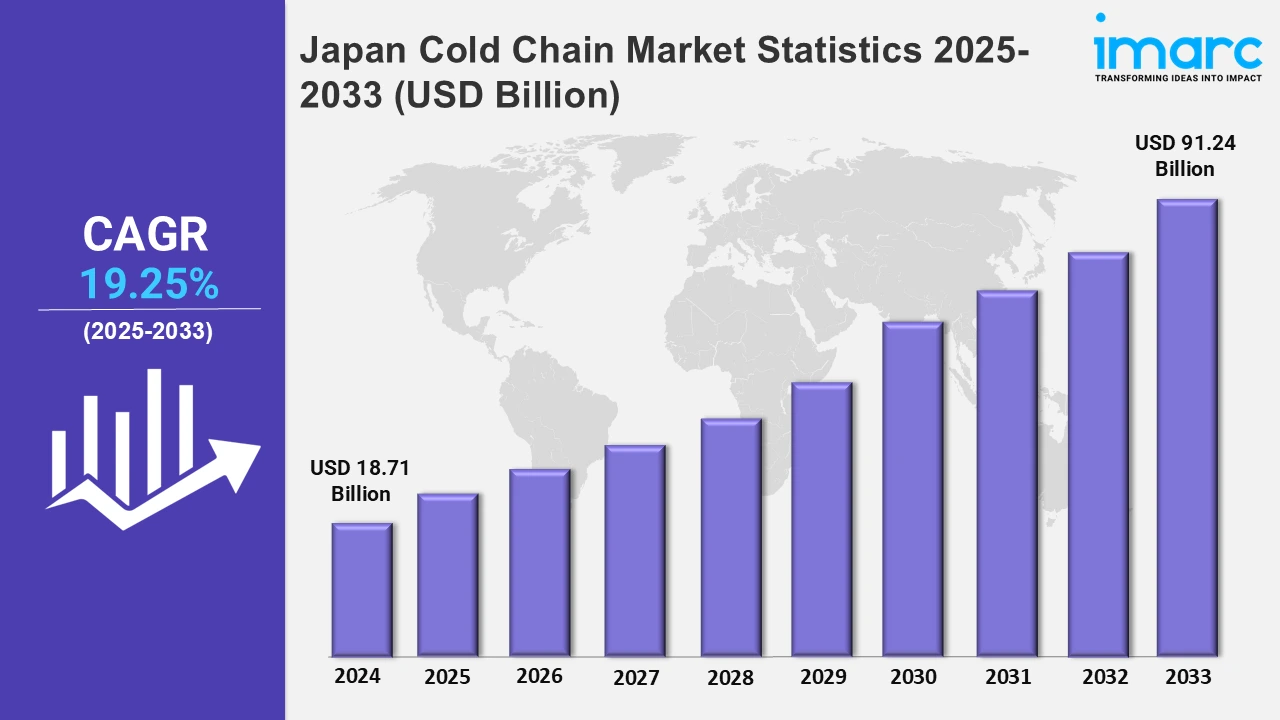Japan Cold Chain Market Expected to Reach USD 91.24 Billion by 2033 - IMARC Group
The Japan cold chain market size was valued at USD 18.71 Billion in 2024, and it is expected to reach USD 91.24 Billion by 2033, exhibiting a growth rate (CAGR) of 19.25% from 2025 to 2033.

To get more information on this market, Request Sample
The Japan cold chain market is witnessing steady growth, primarily driven by the rising demand for temperature-sensitive goods across various industries, including food, pharmaceuticals, and agriculture. With the increasing global focus on product quality and safety, particularly for perishable goods, Japan's cold chain infrastructure is evolving rapidly to meet these needs. Advancements in eco-friendly and energy-efficient cold storage systems are reshaping the logistics landscape, enabling companies to provide sustainable solutions that lower carbon footprints while maintaining stringent temperature controls. In addition, technological innovations in both storage and transport networks, such as automated systems and real-time monitoring tools, are improving operational efficiency and reducing spoilage rates. These improvements not only ensure that temperature-sensitive products arrive at their destinations safely but also help businesses optimize their logistics operations, leading to significant cost savings.
The expansion of cold storage infrastructure is crucial to the market’s development, as modern storage facilities equipped with the latest technologies play a vital role in reducing product wastage. Moreover, the development of cold transport systems, such as refrigerated vehicles and containers, supports the efficient movement of goods across long distances, contributing to the overall growth of the cold chain market. Japan’s government has also played a pivotal role in supporting the sector, offering initiatives and incentives that encourage investment in cold storage facilities and sustainable logistics practices.
Sustainability is becoming an increasingly important driver in Japan's cold chain market. The adoption of energy-efficient systems and natural refrigerants, such as CO₂-based solutions, is revolutionizing cold chain management. For example, in June 2024, a joint venture between Fosun Hive and Idera was launched in Osaka with a JPY 15 Billion investment to develop a state-of-the-art cold storage facility. This facility, designed with eco-friendly refrigeration systems, is in line with Japan's national climate goals, aiming for carbon neutrality. As the demand for sustainable and efficient cold chain solutions rises, these advancements in logistics and infrastructure position Japan as a leader in eco-conscious cold chain operations. The growing emphasis on greener logistics systems, coupled with the use of smart monitoring technologies, enhances supply chain transparency, reduces energy consumption, and minimizes waste, further solidifying Japan's global leadership in the cold chain market.
Japan Cold Chain Market Statistics, By Region:
The market research report has also provided a comprehensive analysis of all the major regional markets, which include Kanto Region, Kansai/Kinki Region, Central/Chubu Region, Kyushu-Okinawa Region, Tohoku Region, Chugoku Region, Hokkaido Region, and Shikoku Region.
Top Companies Leading in the Japan Cold Chain Industry:
The key players in the market are introducing new services and products to expand their market share. For instance, in April 2025, Cold Chain Technologies launched the CCT Tower Elite, a reusable 1600L pallet shipper with IoT-enabled tracking, which is expected to improve the security and reliability of transporting temperature-sensitive goods across Japan.
The market research report offers an in-depth examination of the competitive landscape. It includes insights into market dynamics, strategic positioning of leading players, winning tactics, a competitive overview dashboard, and a company performance matrix. Additionally, the report features detailed profiles of all prominent industry participants.
Japan Cold Chain Market Segmentation Coverage:
- On the basis of type, the market has been categorized into storage [facilities/services (refrigerated warehouse, cold room), equipment (blast freezer, walk-in cooler and freezer, deep freezer, others)], transportation [by mode (road, sea, rail, air), by offering (refrigerated vehicles, refrigerated containers)], packaging [crates, insulate containers and boxes (large (32 to 66 liters, medium (21 to 29 liters), small (10 to 17 liters), x-small (3 to 8 liters), petite (0.9 to 2.7 liters), cold chain bags/vaccine bags, ice packs, others], monitoring components [hardware (sensors, RFID devices, telematics, networking devices, others), software (on-premises, cloud-based)].
- Based on temperature range, the market is classified into chilled (0°C to 15°C), frozen (-18°C to -25°C), and deep-frozen (below -25°C).
- On the basis of application, the market is divided into food and beverages [fruits and vegetables, fruit pulp and concentrates, dairy products (milk, butter, cheese, ice cream, others), fish, meat, and seafood, processed food, bakery and confectionary, others], pharmaceuticals (vaccines, blood banking, others), and others.
| Report Features | Details |
|---|---|
| Market Size in 2024 | USD 18.71 Billion |
| Market Forecast in 2033 | USD 91.24 Billion |
| Market Growth Rate 2025-2033 | 19.25% |
| Units | Billion USD |
| Scope of the Report |
Exploration of Historical Trends and Market Outlook, Industry Catalysts and Challenges, Segment-Wise Historical and Future Market Assessment:
|
| Types Covered |
|
|
Temperature Ranges Covered |
|
| Applications Covered |
|
| Regions Covered | Kanto Region, Kansai/Kinki Region, Central/ Chubu Region, Kyushu-Okinawa Region, Tohoku Region, Chugoku Region, Hokkaido Region, Shikoku Region |
| Customization Scope | 10% Free Customization |
| Post-Sale Analyst Support | 10-12 Weeks |
| Delivery Format | PDF and Excel through Email (We can also provide the editable version of the report in PPT/Word format on special request) |
Need more help?
- Speak to our experienced analysts for insights on the current market scenarios.
- Include additional segments and countries to customize the report as per your requirement.
- Gain an unparalleled competitive advantage in your domain by understanding how to utilize the report and positively impacting your operations and revenue.
- For further assistance, please connect with our analysts.

 Inquire Before Buying
Inquire Before Buying
 Speak to an Analyst
Speak to an Analyst
 Request Brochure
Request Brochure




.webp)




.webp)












